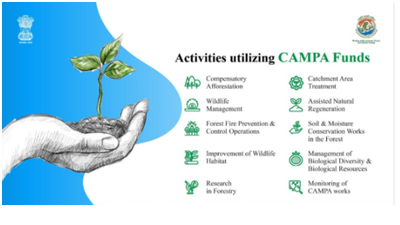Compensatory Afforestation in India
Context: It has been reported recently that land allotted to compensatory afforestation is being ‘diverted’ for non-forest purposes, like industrial or infrastructure development.
What is Compensatory Afforestation?
- Compensatory afforestation means that every time forest land is diverted for non-forest purposes such as mining or industry, the user agency pays for planting forests over an equal area of non-forest land, or when such land is not available, twice the area of degraded forest land.
- The project developers pay for the Net Present Value (NPV) of the forests being cleared, based on a calculation decided by an expert committee.
- According to the recently revised calculations, companies have to pay NPV at rates ranging between Rs 9.5 lakh and Rs 16 lakh per hectare, depending on the quality of forests getting diverted.
- All this money is meant to be spent solely on increasing, or improving the quality of, forest cover in the country, or on works that help this objective.
- The money is parked in special funds created for this purpose at the Central and state levels.
- The money is first deposited in the Central fund, from where it gets disbursed to states where the projects are located.
- The Central fund can keep up to 10 percent of the total money for spending towards administrative expenses. The rest has to be sent to the states according to their share.
- Critics say compensatory afforestation had legitimised clearing of forests, and see it as an example of ‘greenwashing’.
- The contrary view is that since the clearing of forests for one or the other purpose cannot be entirely eliminated, compensatory afforestation is a good mechanism for attempting to make up for these losses to some extent.
How is money divided ?
- The compensatory afforestation law came into being only in 2016, but the concept has existed since the 1980s, as an offshoot of the Forest Conservation Act of 1980, which made it mandatory for project developers to seek ‘clearance’ of the Environment Ministry for any diversion of forest land.
- The practice got institutionalised through the Supreme Court orders and observations during the hearings of the famous Godavarman case in the 1990s and 2000s.
- But due to other litigation, the money collected for compensatory afforestation before 2016 had remained largely unutilised.
- Serious work on compensatory afforestation has begun only after the 2016 Act.
- More than Rs 66,000 crore has been realised in the Central fund through different levies prescribed in that law.
- A substantial part of this — nearly Rs 55,000 crore — has already been sent to the state governments.
- But much of this money remains locked in state government funds.
- State governments have to prepare an annual plan of operations for afforestation work through this money.
- The APOs contain details of money that is intended to be spent during a financial year for specific works related to afforestation.
- Once this plan gets approval from the Compensatory Afforestation Management and Planning Authority (CAMPA) at the Central level, the state government transfers the approved amounts to the state forest departments, which then carry out the work.
Lacks in Implementation
- Government records show that APOs by the state governments have not made full utilisation of the funds at their disposal, and even the money approved for this APOs has not been entirely spent.
- Sporadically, there have also been allegations of misutilisation or diversion of these funds.
- Besides the low utilisation of funds, lack of availability of suitable land remains the biggest problem for compensatory afforestation.
- The land that is made available for afforestation usually cannot be used for any other purpose, and is often extremely unsuitable for growing plantations.
- While there are examples of some good plantations having come up, the poor quality of land poses a difficult challenge in most instances.
- The law mandates at least an equal area of land to be provided for compensatory afforestation, rarely is a contiguous stretch of land made available for this purpose.
- The total area of land is often distributed over twenty or more different locations.
| Practice Question
1. What is compensatory Afforestation? What issues have emerged in policy implementation in recent years? |




